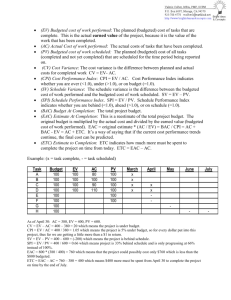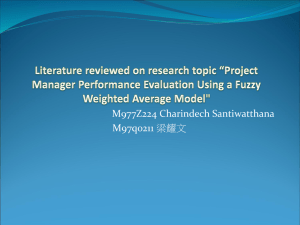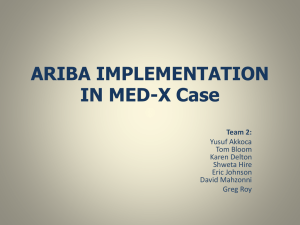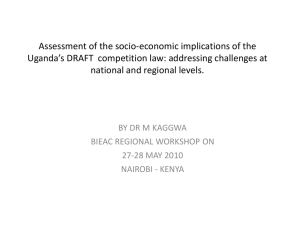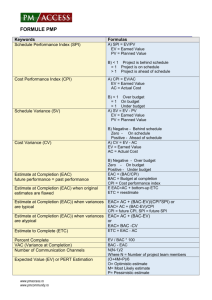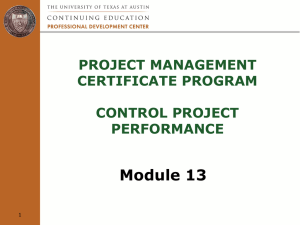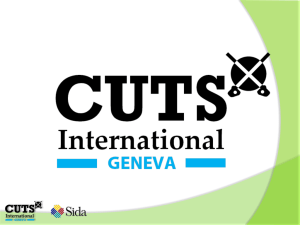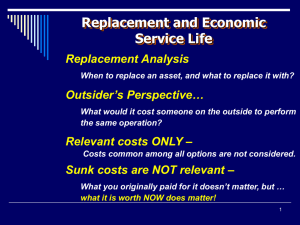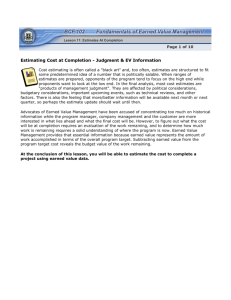Using Program Management Techniques to Be a
advertisement
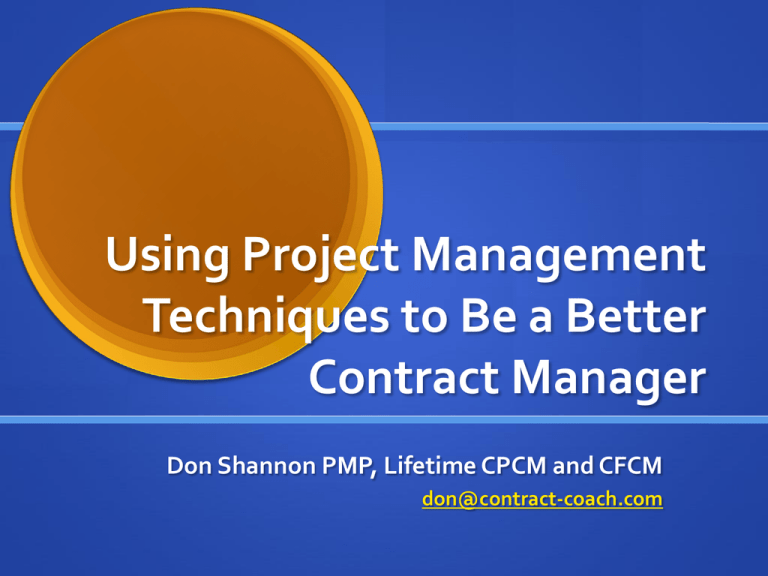
Using Project Management Techniques to Be a Better Contract Manager Don Shannon PMP, Lifetime CPCM and CFCM don@contract-coach.com Overview Project / CM Roles and responsibilities Integrated Project Teams Program Management Techniques Chartering Planning Program Management Plan Program Schedule Program Budget Communications Plan Scope Management Plan Change Management Plan Subcontracting Plan Funds Management Sub-supplier Management Deliverable Management Risk Management Program Management / Baseline Reviews Project / Contract Management Which are you? Which do you choose to be? Project, Program, Contract The Project is a defined set of tasks leading to a desired end result. A Program is a collection of projects or a single large project comprised of smaller units of work which could be called projects. A contract is a legal agreement that enables a project or a program to be performed for the benefit of another. Today I will mix these terms together but understand they are actually different facets of the same entity. If I wish to differentiate between the contract (as a legal construct) and the work to be done I may use the terms “Technical” “Program” or “Project” interchangeably to describe the work PM/CM Roles and Responsibilities PM Exclusive roles Technical management of program Technical documentation Represents upper management with respect to the project Profitability CM Exclusive roles Contractual Management of program Scope Cost Compliance with terms and conditions Advocate for company or agency Lead negotiator Contract documentation Project Team PM/CM Shared roles Customer interface and communication Financial management How/where funds are spent Staying within budget Customer satisfaction Team management approach Sometimes called “Integrated Project Team” (IPT) Led by technical PM CM is advisor on areas of expertise IPT Membership PM1 Contracts1 Safety Quality Accounting / Finance Engineering Logistics Mechanical Electrical Software Training Spares Documentation Manufacturing Key Subcontractors / Suppliers Others as required 1. PM and Contracts are the “Voice of the Customer” IPT Best Practices Meet often “Concurrent engineering” Frequently in early phases where impact is greatest Adjust frequency as program evolves Allows interaction among disciplines to identify and resolve issues up front Reduces cost impact of design changes Why is this important to CM? Co-locate team members if possible Conduct team building exercises Contract Manager Competencies1 Using effective communications Attend contract kick-off meetings Conducting periodic status reviews Preparing written status reports Observe and monitor performance Document performance 1. Contract Management Body of Knowledge, 4th Edition Active vs. Passive Management Active management means: Getting out from behind your desk Meeting with stakeholders to discuss requirements and performance Taking the lead on addressing contract issues Being informed Contract Management as a Customer Service Discipline CM supports PM Advisor for contractual matters Acquisition strategist Contract/subcontract type Competition Manages business matters for subcontracts and consultants Agreements/subcontracts Payment Non-disclosure General Techniques to Improve Customer Service Go on “walkabouts” (Management by Wandering Around aka “gemba walk”) Promotes informal communications with PMs and team Improves understanding of technology and potential issues Demonstrates approachability and willingness to be a team player “Own” the contract / procurement process Be accountable for meeting schedules / deadlines Represent Contracting at team meetings Offer solutions not roadblocks when problems arise Program Management Techniques Chartering Project Planning Program Management Plan Program Schedule Program Budget Communications Plan Scope Management Plan Change Management Plan Subcontracting Plan Funds Management Sub-supplier Management Deliverable Management Risk Management Program Management / Baseline Reviews Chartering Give me a clear statement of what to do and the authority to do it … Chartering Official management statement empowering PM (e.g., letter of appointment etc.) CM needs similar charter to empower them to bind the company signature authority for contract documents negotiation authority Program/Project Planning Plan it like you will do it; do it like you planned it …. Program Management Planning as Applied to Contract Management Management Plan (from PM) Identification of stakeholders Project roles and responsibility matrix Schedule baseline Technical Work Breakdown Schedule Program tasks Time phased actions Resources Contract Management Required reports/meetings Project milestones CM’s should review and offer appropriate input to these plans Conformance to contract and SOW Program Management Planning as Applied to Contract Management Project budget/spend plan Project team Who says what to whom and when? Quality management (see subordinate plan) Roles and responsibilities Communications Management Time phased budget Funding requirements Does it follow contractual requirements Requirements Management / Scope Management (see subordinate plan) Is there a change management plan in place Who is authorized to direct changes What is the change process Communications Plan – What’s in it? What will be communicated Status Reports CDRL Requirements Event driven communications (LOF/LOC) Technical communications Who will (is authorized to) communicate When will information be communicated Where (or to whom) will communications be transmitted Communications Planning Develop mailing/distribution list To primary individual(s) e.g., PCO etc. as per CDRL or other guidance Copy to your PM Update these lists as appropriate Pre-print labels CD Labels, address labels etc. Create boilerplate letters Transmittal of periodic reports Limitation of Funds Set-up reminders in Outlook or other program. Change Control Plan Technical Changes Design changes must be processed by Engineering / Configuration Control function and approved by customer In-scope Generally to address performance or reliability issues May reflect value engineering or address obsolescence Paid for by contractor Out of scope Adding functions or features Revising requirements Changes to delivery location or date Generally paid for by customer Generally results in a contract modification Administrative Changes Appointing officials such as COR Address changes Incremental funding Change Order Processing Configuration Management Product oriented change management Configuration Control Board Establish engineering baseline Once baseline is established CCB must approve all changes to engineering baseline Identify and quantify change impacts Is Contracts a member of your configuration management team? DEMAND a seat at the table! Change Management Change order request/proposal Capture costs of change Identify ‘who pays’ Unique job number for each change Track incurred costs for change Ensure proper accounting of costs Subcontracting Plan Not to be confused with small business subcontracting plan Part of “make/buy” determination What work will be subcontracted and by what basis Teaming agreements Small business set-asides Competitive subcontracting Procurement of materials Subcontracting Contracts Manager Responsible for ‘flow-down’ requirements Creates and negotiates agreement1 Monitors subcontractor performance1 Coordinates funding requirements1 Coordinates payment issues1 1. This function may be delegated to a sub-contracts or supply chain management function Funds Management Money is the lifeblood of a project: the Contract Manager’s job is to keep the arteries full and monitor the blood pressure ... Funds Management How much funding do you need? When do you need funding? How much funding remains? Can you complete the contract effort with the allotted funds? Cost / Funds Management Consequences rely on contract type Cost contract Overrun Stop work Incomplete effort Fixed Price Profit/loss Long term future of the enterprise CM must provide appropriate notices Limitation of Funds Limitation of Cost Special requirements Guaranteed Final Report clause Sample Project 4 Primary Tasks System design Hardware Design Software Design Functional Prototype 12 Month Duration Approximate $4,000,000 total cost Incrementally funded CPFF Contract Sample Project Schedule Sample Project Cost Sample Project Funds Planning $4,500 $4,000 $3,500 $3,000 LOC $2,500 $2,000 $1,500 LOF1 $1,000 $500 $0 Jan Feb Mar Apr May Jun Jul Aug Sep Oct Nov Planned LOF1 Notice 1Assumes FAR 52.232-20 & -22 parameters are 60 LOC1 Notice days and 75% Dec Funded Commitments Commitments = Purchase Orders Materials Components Subcontracts Incremental funding Termination costs Can not commit in excess of funding “Spent = actual + commitments” Adding Commitments to Cost $4,500 $4,000 $3,500 $3,000 $2,500 $2,000 $1,500 $1,000 $500 $0 Jan LOF Notice Feb Mar Apr May Jun Jul Aug Sep Oct Commitment Planned Funded Actual Actual + Commitment Estimate @ Complete Nov Dec Cost Performance Monitoring May be required for contracts > 1 Million and > 6 Months. Contractor format is acceptable. DIDDI-MGT-81468 provides for tailoring requirements to ensure only minimum information required for effective management control is obtained from contractor. Generally N/A to FFP contracts Schedule Performance Monitoring Earned Value Management System Implementation (e.g., FAR 52.234-2 or DFAR 252.234-7001 or -7002) can be expensive Usually reserved for large programs (> $20M – $50M) Usually reserved for programs > 1 year ANSI Standard 748 requires compliance with 32 separate guidelines Oftentimes the processes needed are in place – especially in ISO 9000 organizations Full implementation is not needed unless required by the contract Significant benefit can be derived by simply using EVMS techniques to monitor performance Tracking cost performance Projecting Estimate at Completion EVMS = Cost + Schedule Monitoring Variance Analysis On/Slightly Behind Schedule. Why? $21,000 Under Cost. Why? Why Costs Never Meet Projections Driving by rear-view mirror Assume future costs or performance will mimic past performance Any anomalies were ‘bumps in the road’ Straight line projection based on known spend rates. “Political” Pressures Must finish within budget Advocacy by Program staff Estimate at Completion (EAC) EAC = Actual Costs to Date + Estimate to Complete (ETC) Estimate to Complete = Budgeted Cost of All Work – Budgeted Cost of Work Performed adjusted for: Cost performance to date (CPI) CPI = Budgeted Cost of Work Performed ÷ Actual Cost .85M Budgeted ÷ 1.0 M Cost = CPI = .85 CPI > 1 is good If CPI < 1.0 project is overrunning cost If 2M in work remains and CPI = .85 the cost to complete (ETC) is likely to be 2.35 M Cost at completion (EAC) would be 1M + 2.35M = 3.35M Risk assessment Risk events can impact costs and their impacts should be considered How? Stay tuned …. Defense Acquisition University EAC Fundamentals Recurring Themes in EAC Research PM’s are optimists Things will get better Just a bump in the road Programs Do NOT improve over time EVM based EAC can provide insights Three Categories of EAC EVM Performance Factor Based EAC Regression Analysis Easiest to do re: previous example on slide 42 Use Cumulative CPI to adjust estimated cost of work remaining Several techniques possible - provides a range of values rather than single point Fit a curve to project cost based on historic data Extrapolation errors possible when estimating outside the data’s range Risk Based – Forward Looking Uses Monte Carlo simulation tool to estimate remaining risks Best when combined with a Program Evaluation and Review Technique Schedule Uses range of data for task duration rather than single estimate Optimistic, pessimistic, and most likely Provides range of values and confidence intervals Deliverables Management Deliverables fulfill contract requirements. Make sure they are on time, conform to requirements, and that you document their delivery and acceptance. Deliverables Management List of deliverable items Schedule of deliveries Soon to come due listing Memory ‘ticklers’ Transmittal documents DD250 Letter of transmittal Notice to invoice Create and Maintain a Deliverable Item List / Schedule Risk Management Murphy was an optimist …. Implement a Risk Management Program Identify contract (program) risks and document them in a risk register Risks include opportunities as well as negative events Perform a qualitative risk assessment for each risk Likelihood of occurrence Consequences Prioritize risks based on composite score Develop mitigation, transference, or avoidance strategies for top scoring risks Quantitative Risk Analysis Statistical techniques used to quantify risk Assign probability or confidence interval to events Estimate cost or impact Best when integrated with schedule Identify likely completion date(s) Identify final cost Software based solution May take special training to use or interpret results Performs complex analysis including interaction and ‘what if’ scenarios Risk Management is an Ongoing Effort Periodic meeting to review and reassess risks Monthly during first stages of project At least quarterly thereafter Mitigation strategies should be reassessed over time Still viable Has risk changed Update the risk register to add new risks or retire risks that no longer threaten Program Reviews The program team must be accountable for the performance of their projects … Program Reviews Coordinate actions and inform stakeholders Monitor progress Identify / discuss program / contract issues Approve decisions Program Review Content Adjusted to fit the organization’s needs Should Include Technical accomplishments Schedule update Items completed since last review Deliveries made Delays or issues requiring assistance Get well plan for late activities Financials Performance to date Funds remaining Additional funds required May include Upcoming events Staffing Problems or solutions needing approval Lessons learned Summary What to take with you as you leave Key Points Contract Management requires involvement Get out from behind your desk and talk to people Take responsibility for the contract Budget Deliverables Property management Reports Take the initiative to identify and resolve problems Key Points Contract Managers are team players Get to know your teammates and learn how to work with them We’re not gatekeepers so our approach should be “Tell me what you want to do and I’ll tell you what we need to do that” Be proactive Don’t wait for a problem to bite you if you can head it off beforehand Offer solutions to perceived problems Key Points Stealing from the other guy’s toolbox is OK Be sure you understand your charter Participate in project (program) planning and share input with the team Change Management Communications Management Cost Management Plan it like you’ll do it … Do it like you planned it. Using advanced tools such as EVMS and Risk Management will enhance your ability to do your job Learn the basics Learn the lingo Apply the techniques Key Points Program reviews are necessary Be prepared to brief contract status Funds issues such as LOF or LOC Payment or invoicing as required Period of Performance etc. Reports and deliverables Be prepared to assist others Notifying appropriate officials of issues or changes required Offer strategies for success That’s all folks! Don Shannon PMP, CPCM The Contract Coach don@contract-coach.com http://www.contract-coach.com

